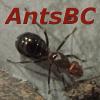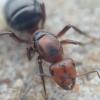Just a quick ID thread. I was at a friend's house helping with some gardening, and we noticed that these smallish golden ants were under EVERYTHING. Almost every rock we picked up, there were dozens of them underneath. But, they don't seem to make any anthills that we could find. I've got a picture, I didn't have anything for scale but I'd say they're around 0.3-0.5cm. Found near a forest in upstate NY. Thanks!
















